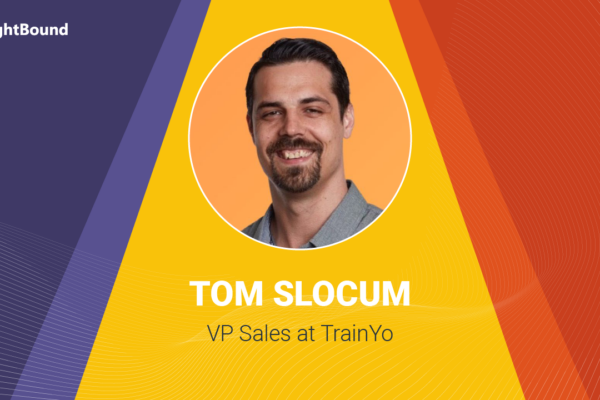
With 20 years of selling at some of the world’s top SaaS companies, Justin Michael is the co-founder of HYPCCCYCL, the #1 GTM simulation interactive learning community. Having advised over 200 SaaS startups on cracking the top funnel, his best-selling book “Tech-Powered Sales” is a guide for sales leaders and companies looking to build a scalable and repeatable sales machine.
What’s the strongest trend you recognize in sales development today?
Without a doubt automation. It’s not just the use of artificial intelligence and machine learning, but actually realizing their promise. A great example is AI-powered sales assistance – think of an AI “Jarvis” that’s taking manual work off the rep’s plate. The other big trend I see is sales leaders waking up to the potential of B2B ad targeting and retargeting, and starting to think more like marketers.
“…sales leaders [are] waking up to the potential of B2B ad targeting and retargeting, and starting to think more like marketers.”
What will sales development look like in 2030?
I think the first thing we’re going to see in the future is the major marketing clouds buying up point solutions. I call this M&A popcorn. We’ll also see writing being replaced by GPT-3. When our sequences and cadences are suggested by automation, we’re going to be able to take the heavy lifting off the rep.
Automated and autonomous solutions, like RightBound, will handle data targeting, analysis, list building, and even the outreach and initial contacts. This will free up SDRs to spend more time on downstream activities like qualification, but that doesn’t mean SDRs will disappear. Their role will morph into a different flavor of inside sales or full cycle sales.
What KPIs do VP Sales need to track and why?
There is a traditional metric called a “complete” that refers to whether there was a human to human interaction. This KPI is important because if you nail your tech stack, there are a lot more live conversations over zoom or in person.
Another KPI is time spent selling. According to a survey conducted by InsideSales.com, sales reps spend only 37% of their time selling. This figure needs to be ramped up to 60, 70 or even 80% (think of the 80/20 rule).
The third KPI would be conversion rates on accounts. This is similar to the ABM concept but flipping it to account-based sales development (shout-out to Lars Nilsson for this one). So if you’re assigned 200 accounts, you need to measure the percentage of those accounts that turn into a qualified opportunity.
What questions should VP Sales ask when interviewing SDRs or AEs?
In my book I talked about upskilling your technology quotient. Along with that, if you have a modernized tech stack, you also need to have a cultural fit. Your SDRs should have a lot of grit, adaptability and coachability (credit to Mark Roberge’s hiring profile). When interviewing candidates, ask them to walk you through situations, explain specifically how they drove the last deal, how they targeted the triggers, which tech stacks they used, messaging, outreach, and how they handled the resistance in the sale. The aim isn’t to interrogate or expose, but just to really understand their circuitry, the way they process a deal and what kind of team player they’re going to be.
“According to a survey conducted by InsideSales.com, sales reps spend only 37% of their time selling.”
What’s a good SDR-AE ratio for a growing sales department?
It’s a luxury to have an SDR for each AE. Obviously, feeding the AEs with more SDRs is going to increase results. But it really comes down to how effective your SDR team is. You’ll see SDR to AE ratios of 2:1 or 3:1, but you’ll also see companies with shared SDRs where one SDR supports two or three AEs. If the SDR layer is using the tech stack layer efficiently, each SDR can feed more AEs.
How can sales teams use remote work to their advantage?
Rubbing elbows, shaking hands and having dinner (which we’re not doing much anymore) will always be valuable. That said, the efficiency gains from conducting 5-10 targeted zoom calls per day or connecting with five continents in one hour are extremely powerful. I think remote work allows for a high degree of focus if you can really be “present,” while also allowing you to enjoy work-life integration. Given the advantages of both, I think the future will be characterized by a hybrid model.
What part of sales development shouldn’t be automated?
I’ve been analyzing this market for five years, automating everything possible, and even wrote a book about it. I really believe that automated solutions, such as RightBound, are the future because they’re eliminating manual tasks using autonomous AI-driven machines. But what can never be replaced is the human to human interaction, which when done correctly requires compassion, empathy and caring. That piece will always be a dynamic role that humans play, and it’s very hard to automate.
What is the essential sales tech stack for modernized selling?
My book talks about categories of tech, and I outlined an essential stack for modernized selling. Step one is Sales Navigator – you need self-healing CRM data which means LinkedIn and 840 million profiles. Then you need to verify the phone numbers and emails of those people and you need intent data and triggers. Next you need to automate the emails and the cold calls using parallel dialers and other tools. But the key to making the tech stack work efficiently is to offload the time-consuming and tedious work of warming up the top of your funnel. That’s exactly what RightBound is doing, and the value is that it enables SDRs to focus their efforts on booking more meetings.
“It’s a luxury to have an SDR for each AE… If the SDR layer is using the tech stack layer efficiently, each SDR can feed more AEs.”
What are some of the top sales communities that SDRs join?
I’m a huge proponent of sales communities. I think if you’re passionate about sales, go create a group on Patreon. I would recommend Kevin Dorsey’s and Scott Leese’s groups. My co-founder at HYPCCCYCL, Julia Nimchinski, and I host a community called “GTM Slack.” There are also specialized RevOps Slack communities like Wizard of Ops. Alongside these communities, B2B content hubs like Sales Feed and Corporate Bro are doing fun sales videos and other resources. Honorable mention would be Chris Ortolano’s SalesStack.io.
Can you describe a challenge that one of the companies you’ve consulted had and how they cracked it?
The biggest challenge is opening – opening is the new closing. It’s all about cracking the top funnel. Most SaaS companies have closers – whether it’s the founder, the CEO or the GM – but they’re just not getting enough funnel. Their pipeline is anemic. They have automated email sending platforms and power dialers, but they’re experiencing less opportunity flow than ever, and 60% of sellers are missing quota. Why? It’s because the space is so noisy, and to rise above the noise, you need to raise your technology quotient (TQ). This means leveraging the right tech stacks and expert platforms like RightBound to take the heavy lift off your reps.
How can sales organizations create their own leads and rely less on inbound?
You can’t rely on the quality of inbound leads, so you have to go outbound. You might have a cannon that can send 10,000 emails per week, but you’re better off slowing down, finding the top 200 targets, and going into accounts that are already in the buying window (based on intent data) with a very relevant message. To do that you need a way to ensure your team is working on warmer leads lower in the funnel.
Many SDR companies are running human SDRs with some tech stack, but they’re not trying to fully automate the top funnel. What I like about RightBound is that you’re committed to automation, but without replacing the SDRs. You’re feeding the SDRs warmer leads – almost like a new MQL.
While it may sound counter-intuitive, very high quality outbound produces better inbound through a flywheel effect. So a great way to improve your inbound is to fix your outbound – then the flywheel moves towards you.

